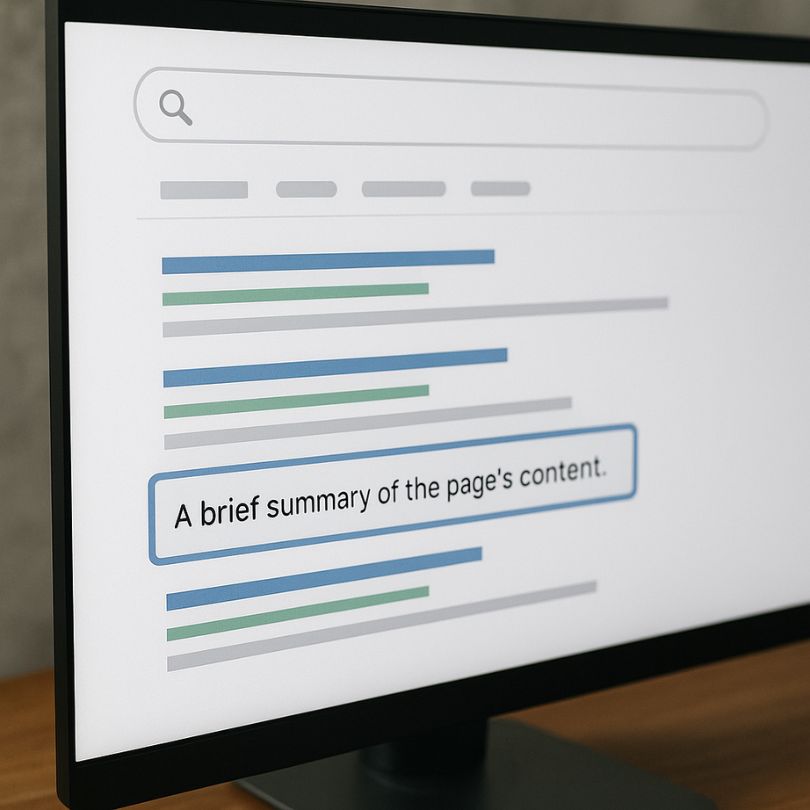
Creating Effective Meta Descriptions: The Complete Guide for Higher CTR

Effective meta descriptions are the short, persuasive blurbs that sell your page to searchers before they ever click. While not a direct ranking factor, they dramatically influence click-through rate (CTR), which feeds user signals back to search engines and helps the right audience find you. In competitive results pages, a clear, credible, and curiosity-provoking description often makes the difference between being scrolled past and being chosen.
Think of a meta description as your 155-character elevator pitch: it must capture intent, convey value, and invite action—fast. Search engines will sometimes rewrite your snippet, but strong author-provided descriptions still win more often than not. For guidance on how snippets are generated and when they can be replaced, review Google’s official documentation on search snippets, then use the best practices in this guide to maximize your odds of being displayed as you wrote it.
Great descriptions align with both the query intent and the on-page promise. If your page solves a problem, say so plainly; if it compares options, highlight the comparison; if it explains a concept, surface the primary takeaway. In all cases, prefer specificity over fluff, concrete outcomes over vague claims, and verbs over adjectives. Readers skim; your job is to make the benefit scannable.
Competitive inspiration can also sharpen your copy. Skim the top results for your target query and note patterns in language, numbers, and calls to action. Observe how brand voice shows up in regulated industries versus content-heavy niches, and how commercial pages differ from informational ones. When researching broader creative angles, even outside of search, you can study hooks and value props used in native ad spy tools to see what consistently captures attention—then adapt ethically and accurately for searchers.
What is a meta description?
A meta description is an HTML element that provides a concise summary of a page’s content. It is typically displayed as the gray (or dark mode equivalent) snippet beneath the blue title link on a search results page. The best ones preview the answer a searcher expects while making a compelling case to click.
How meta descriptions influence SEO (indirectly)
While meta descriptions are not counted as keywords for ranking, they heavily affect user behavior. When more searchers click your result and stay to engage, that engagement signal often correlates with improved visibility over time. In short: they won’t rank you by themselves, but they can earn you more of the traffic your content deserves.
Anatomy of high-performing descriptions
- Length with purpose: Aim for 145–160 characters on desktop, but optimize for clarity over rigid limits. Mobile snippets vary. Avoid burying your main value at the end.
- Benefit-led value prop: State the outcome or benefit users get from your page—save time, compare prices, follow a checklist, or avoid a common mistake.
- Intent alignment: Match the search intent (informational, navigational, commercial, transactional) with clear language that signals the page type.
- Brand tone: Keep voice consistent with your brand. Friendly and helpful for guides, concise and credible for product pages.
- CTA & specificity: Invite the click with verbs like “Learn,” “Compare,” “Download,” “Explore,” and anchor them in something concrete.
- Numbers & symbols: Use digits (e.g., 7 steps, 2025 update) and separators (– or |) to structure information and stand out visually.
- Keyword presence: Include your primary keyword or a close variant naturally; bolding in SERPs improves scannability and relevance.
Recommended length and truncation
There’s no fixed character limit—Google truncates based on pixels, device, and language. A practical range is 145–160 characters. What matters most is front-loading your primary benefit and intent signal. If the tail gets cut, the core message should still land.
Step-by-step process to write better meta descriptions
- Clarify the intent: Is the page explaining, comparing, listing, or selling? Choose language reflecting that purpose.
- Extract the unique value: Identify the most specific promise your page can make that competitors don’t. Lead with it.
- Draft two angles: One direct/benefit-first variant and one curiosity-led variant. Keep both honest and on-topic.
- Check SERP fit: Compare the draft to page-one competitors. Does it feel more useful, clearer, or faster to understand?
- Front-load keywords: Use your focus term (or close variant) early, but keep wording natural for real humans.
- Tighten with verbs: Replace soft adjectives with active verbs. Remove filler. Make every word carry weight.
- Validate against the page: Ensure the description matches the content. Misaligned promises increase pogo-sticking.
- Ship, measure, iterate: Publish, watch CTR, and revisit underperformers with fresh variants.
Templates and examples you can adapt
- Benefit-first (informational): “Effective meta descriptions: learn how to boost CTR with proven formulas, real examples, and a quick checklist.”
- Problem–solution: “Low CTR? Write effective meta descriptions that match intent, add value fast, and earn more qualified clicks.”
- List/guide: “Effective meta descriptions explained: length, templates, and 10 expert tips to increase search clicks.”
- Commercial intent: “Compare the best [product]: features, pricing, and honest pros/cons—plus buying tips you can trust.”
- Transactional intent: “Shop [category]: curated best-sellers, transparent specs, and helpful reviews—buy with confidence today.”
- Local intent: “Find the top [service] near you: verified providers, pricing insights, and scheduling in minutes.”
Advanced tips (beyond the basics)
- Use dynamic keywords carefully: Programmatic insertion can help at scale, but keep meaning intact and avoid awkward phrasing.
- Leverage structured data: While schema doesn’t control descriptions, rich results (ratings, price) complement your snippet and attract clicks.
- Handle pagination: Make page two and beyond distinct. Reflect what’s new or continued to prevent duplicate-looking snippets.
- Localize thoughtfully: Translate intent and idioms—not just words. Keep character limits and cultural cues in mind.
- Mind sensitive YMYL topics: Emphasize expertise, evidence, and clarity. Over-claims erode trust and can affect visibility.
- Test seasonality: Update descriptions for major events (holidays, back-to-school, year-in-review) when relevant.
Common mistakes to avoid
- Keyword stuffing: Repeating terms makes copy wooden and turns users away. One natural mention is enough.
- Generic claims: “Best tips ever” says nothing. Replace with a concrete benefit or number.
- Duplication at scale: Audit templates across large sites; thin or identical snippets waste your crawl equity.
- Misleading promises: Earn the click you can keep. If the page can’t deliver, adjust the description or the content.
- Throwaway endings: Don’t hide the benefit after character 160. Put the meat up front.
- Quote marks and odd characters: Avoid characters that can break snippets; prefer simple punctuation.
Measuring success and optimizing over time
Monitor impressions, CTR, and average position in your analytics and search console. Prioritize pages with high impressions but below-average CTR; they’re your fastest wins. Test contrasting angles—benefit-forward vs. curiosity-led—and annotate changes so you can attribute improvements. Segment by page type (blog, product, category, glossary) since winning patterns vary. Revisit heavy hitters quarterly, and refresh long-lived evergreen posts annually or when intent shifts.
Workflow and quick checklist
- Confirm page intent and the main user question you’re answering.
- Scan current SERP: note patterns and gaps your page can fill.
- Draft two 145–160 character variants, front-loading the benefit.
- Place the focus keyword naturally near the start.
- Ensure accuracy with the on-page content; no bait-and-switch.
- Publish, measure CTR, and iterate on underperformers.
FAQ
Do meta descriptions directly affect rankings?
No. They’re not a direct ranking factor, but they influence CTR and user behavior, which correlates with visibility and traffic.
What’s the ideal length?
There’s no perfect number. Aim for ~145–160 characters, but prioritize clarity and front-loaded value over strict limits.
What if Google rewrites my description?
It happens when search engines think a different passage better matches the query. Strong, intent-aligned descriptions are still used frequently, and they provide a baseline even when rewrites occur.
Conclusion
Mastering effective meta descriptions is about empathy, clarity, and iteration. By aligning to search intent, leading with a concrete benefit, and refining based on real CTR data, you can win more qualified clicks without writing a single new article. For broader marketing inspiration on messaging and offers, explore this step-by-step playbook, then adapt the lessons to your snippets. Keep testing, keep learning, and let your descriptions do the quiet work of earning attention.